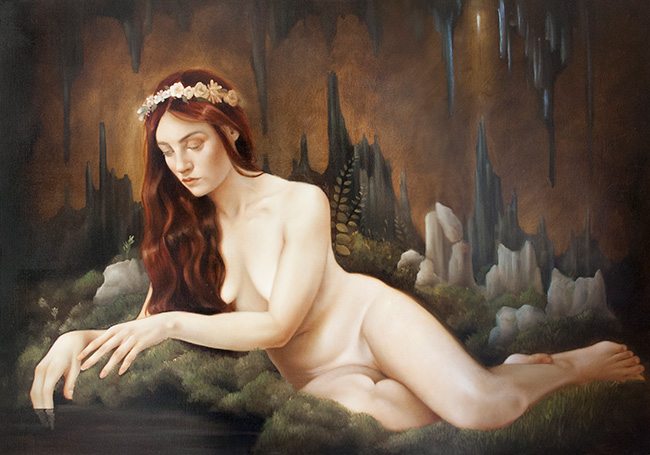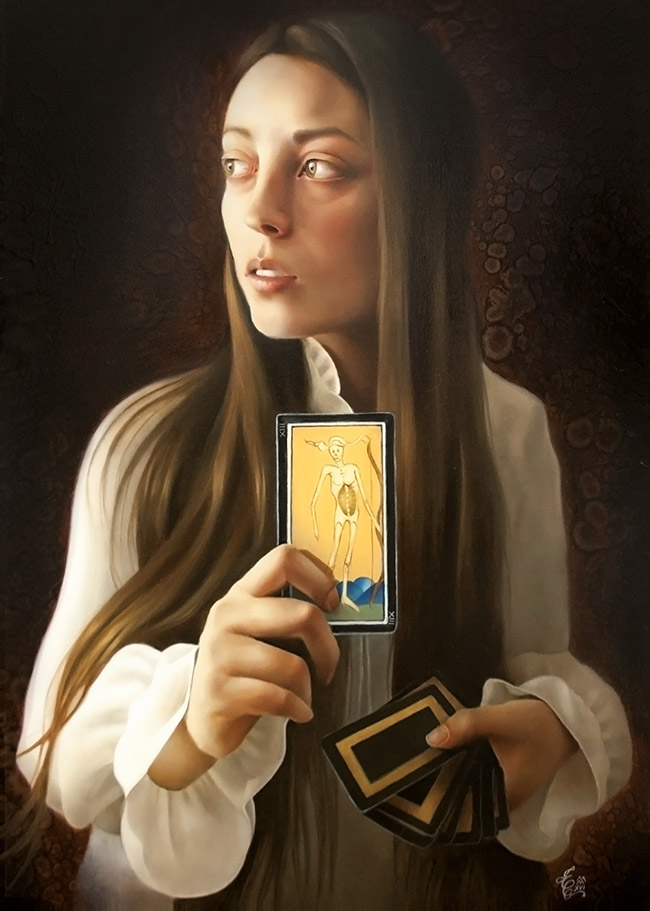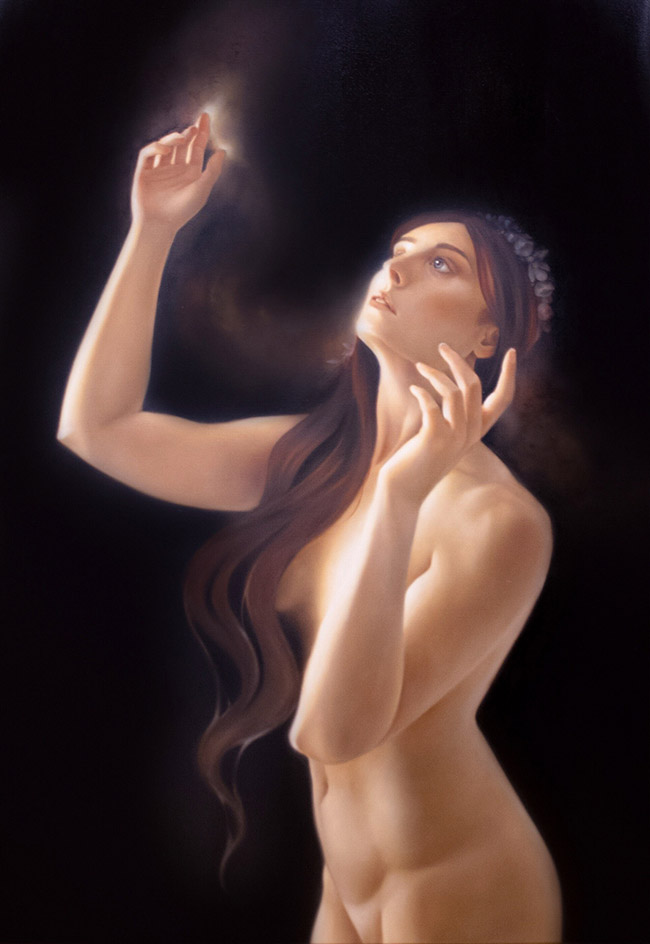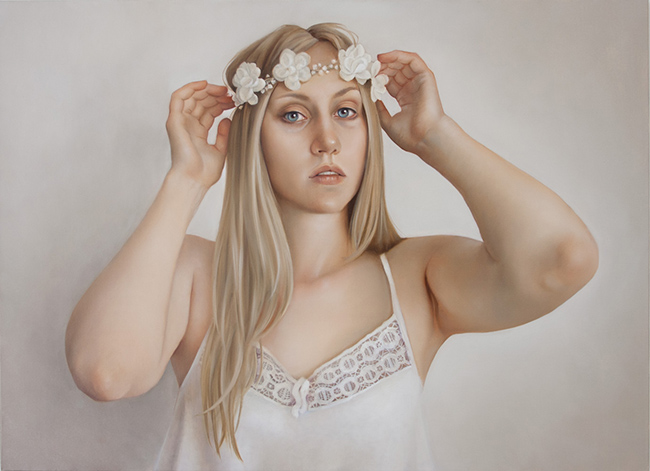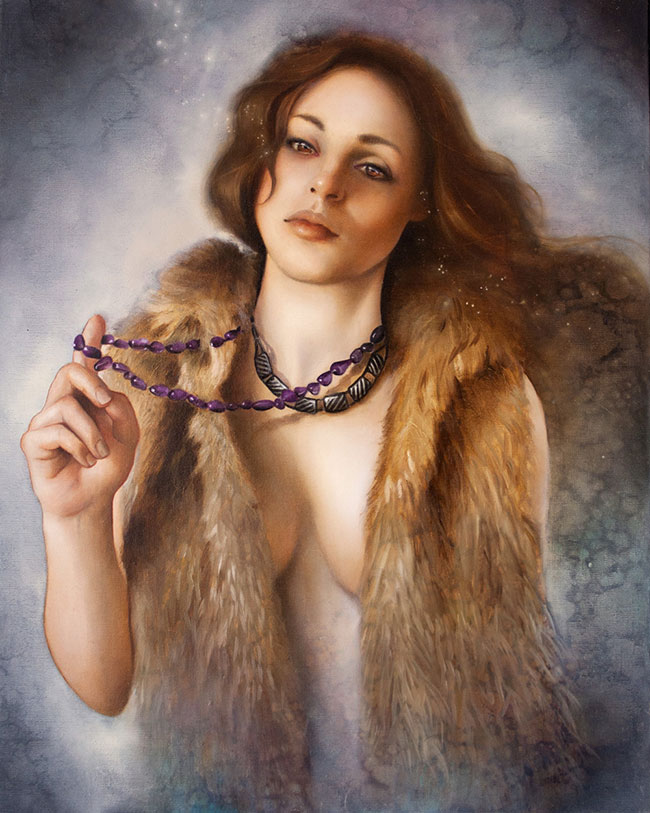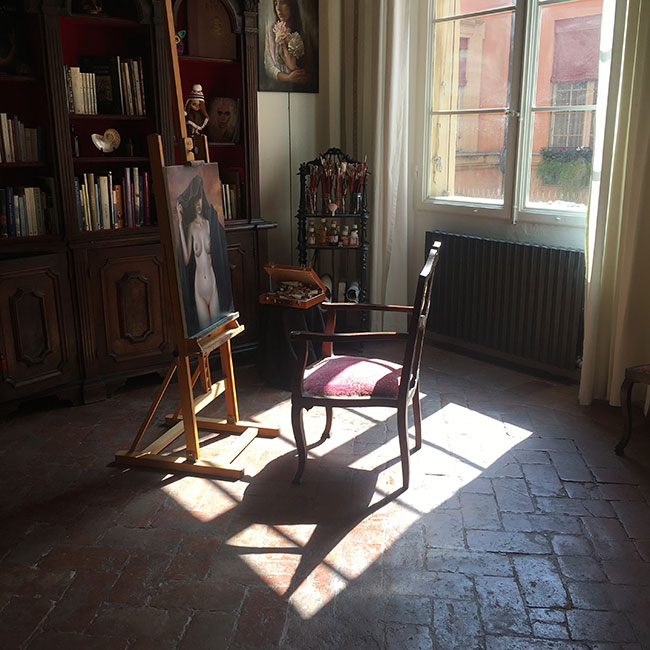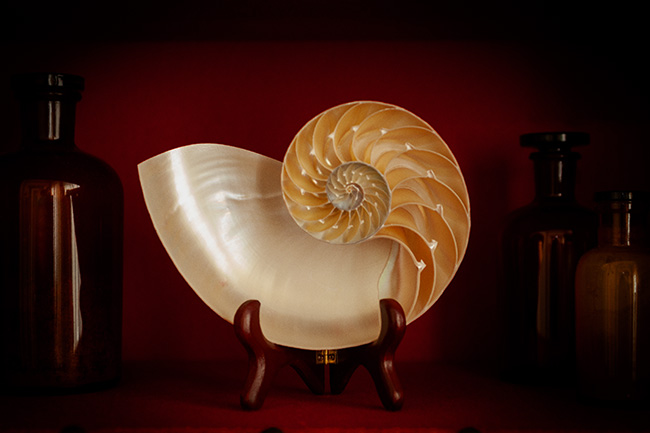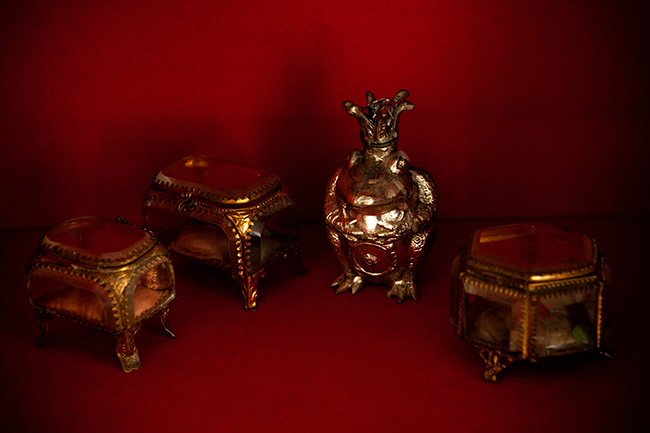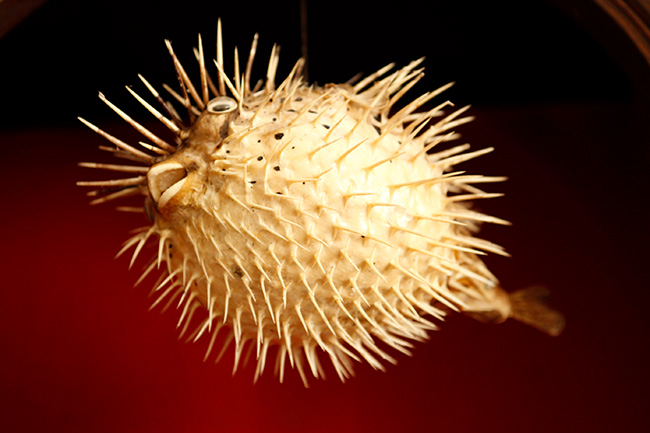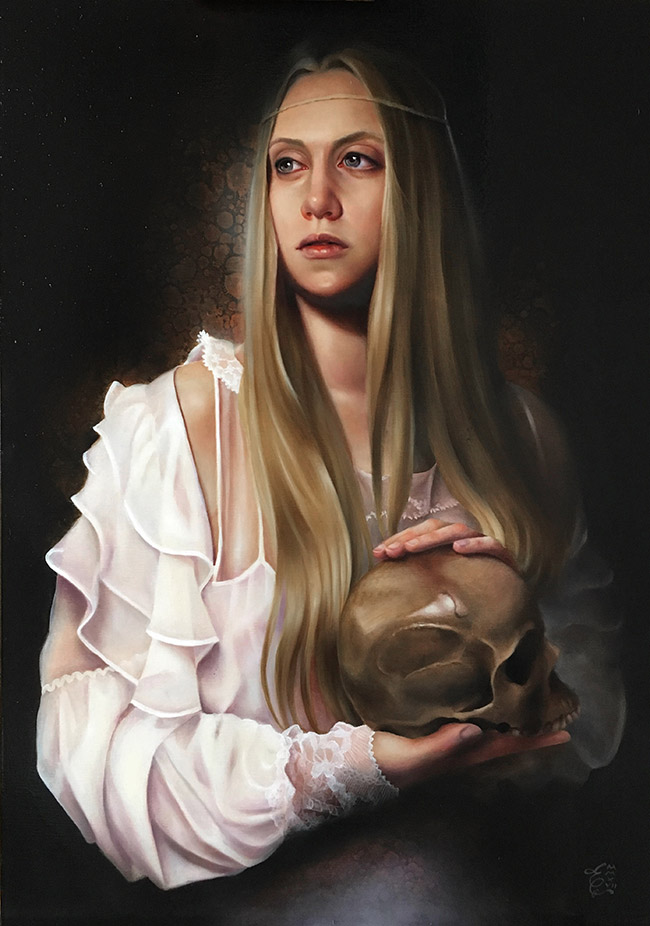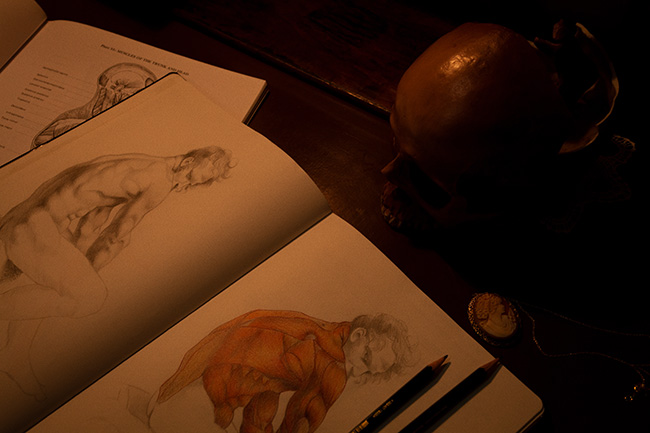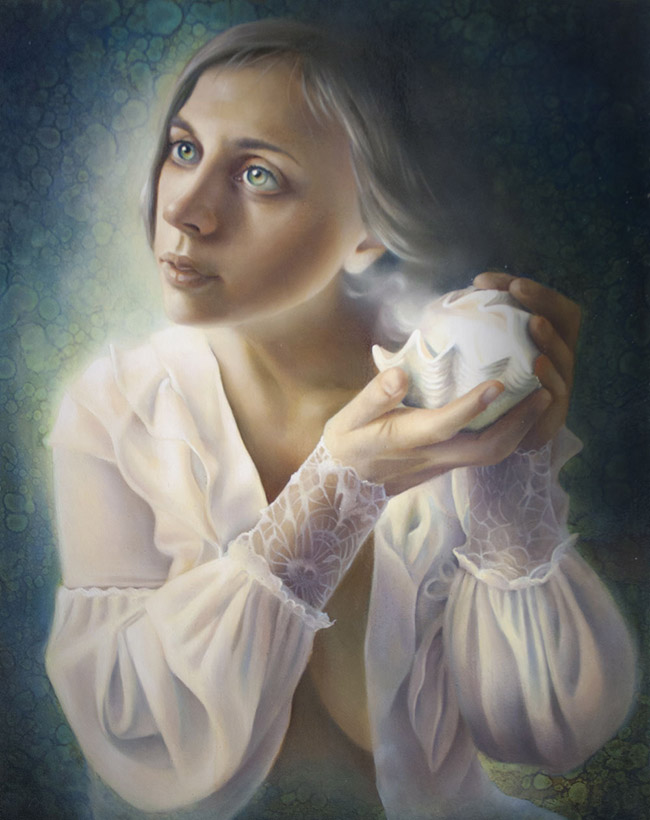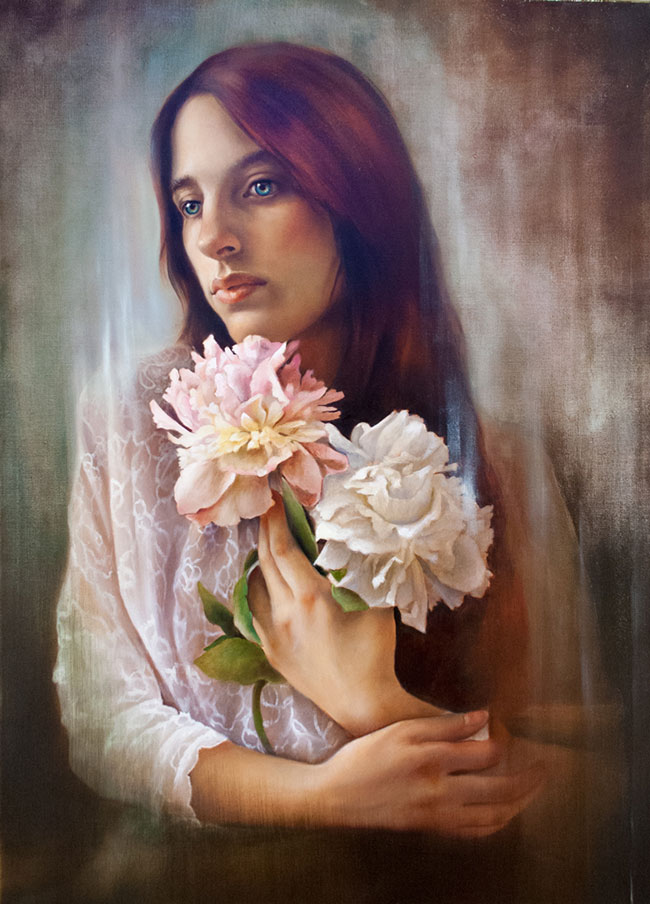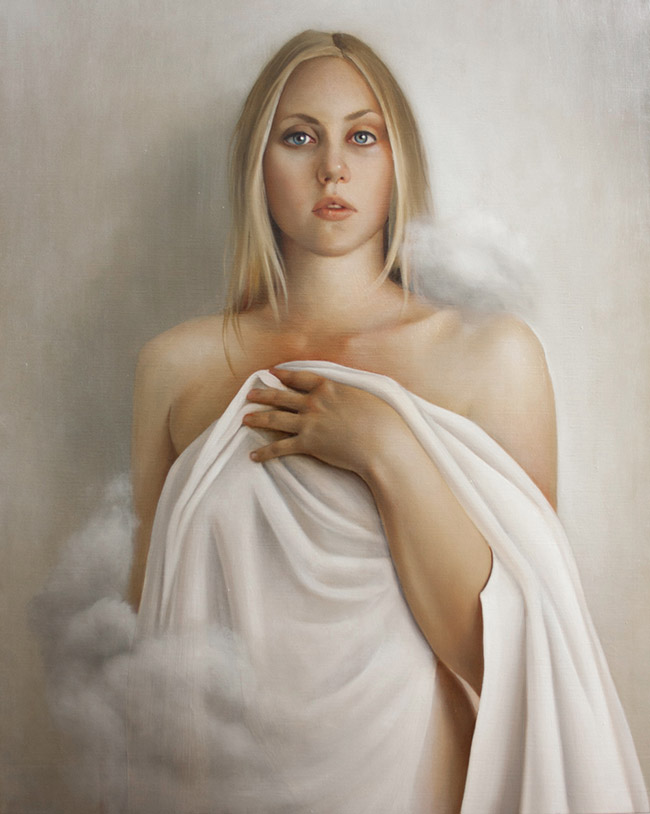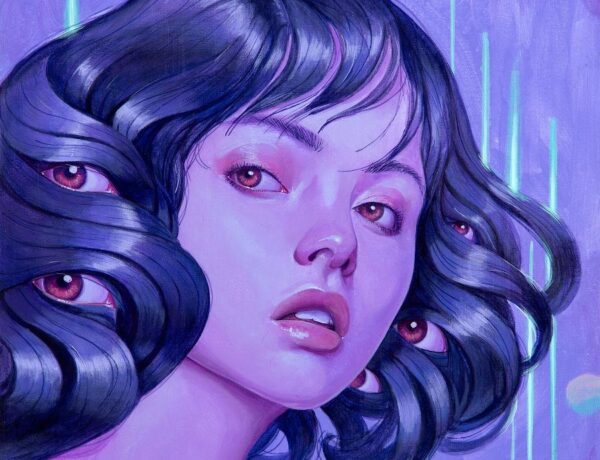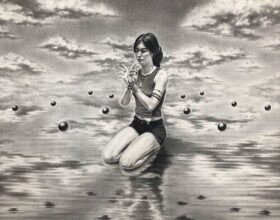Let me start at the beginning. This charming tale – full of flowing hair, rich symbolism, delicate lines and enchanted nostalgia – begins, like all good stories, with a dream. Fairy tales, paintings, dreams, castles, and Renaissance throw-backs… welcome to the whimsical world of Italian figurative artist Erica Calardo.
“Working with oils, watercolours, graphite, [and] dreams”, her paintings gives a stylistic nod to the Late Renaissance, Mannerist and Early Baroque artists, and sparkles with the same dreamy kinda’ magic Erica lives in every day. Her ingenuity, creative moxie and figurative skills make for a nuanced story beckoning further exploration; so, without further ado, join for an imaginative deep dive with this global contemporary talent, Erica Calardo.
Erica’s upcoming exhibition schedule: (held in two galleries simultaneously, with two works per artist)
“Esprit de Corps”
Modern Eden Gallery
Exhibition Dates: November 9–December 8, 2019
San Francisco
The (new) work exhibited is “Esperos – The Evening Star” (still in progress)
“Esprit de Corps”
Haven Gallery
Exhibition Dates: November 9–December 8, 2019
Northport, NY
The (new) work exhibited is “Phosphors – The Morning Star” (still in progress)
La Vida Es Sueño (citation of Calderon de la Barca), oil on linen, 2018, 70x100cm (27.5×39.4 in); available, contact Erica at info@popandbaroque.com
Your Twitter bio says: “Artist. Painter. Logician. Cat Lover. Dreamer.” What have you been dreaming about as of late?
La vida es sueño [Life is a Dream] – everything starts there. I believe that when we dream we elaborate in a symbolic, figurative way what we live, what we fear, what we desire. Through dreams our subconscious mind tries to communicate on a deeper level. I’ve always had strange dreams, weird images, things that at some point happen. Sometimes I start painting without a specific idea and I see symbols I can’t understand appearing.
Last year, for example, I got obsessed by the “Lament of Nymph” by Monteverdi. I would listen to it constantly. Then I started a painting. I didn’t know what I was doing, I just painted this figure; she looked like a nymph, but I didn’t know what to do with it. I kept going; I painted a sort of landscape around her.
I understood it was very symbolic, that this painting was really telling me something but I could not understand its language. [In the painting] there is a nude [female] figure caressing dark waters, there are rocks and plants all in a very dark setting, and a star shines bright, far away. One day I got up and felt it was finished. I made love with my husband and set to start a new work. That very night I dreamt of a baby boy fluctuating in front of me, and I remember asking if he was really mine. A disembodied voice in my head said “Yes.” I say, “So, am I really your mom?” Again, “Yes.” Embracing the baby, I then took it swimming with me in a deep circular pool.
That was the day I got pregnant. When, a couple of weeks later, I discovered [this], I went back to the nymph painting… I could now see its symbols and what my mind was trying to tell me: the water; the cave – they tell a story of fertility, of maternity. The water is dark, mysterious, yet clear and fresh; and the nymph is gently caressing it, [her mood] meditative. She’s about to abandon herself to the waters and is captured on the verge of it, on the boundary, when she is about to throw herself into Nature’s arms.
Lament of the Nymph (citation of Claudio Monteverdi), oil on linen, 2018, 70x100cm (27.5 x 39.4in); not available
Somnium Virginis (citation of Somnium Scipionis by Cicero), oil on linen, 2018, 60x80cm (23.6×31.5in); available, contact Erica at info@popandbaroque.com
How does being a logician shape, benefit, challenge your journey as a visual artist, and vice versa?
Logic is the land of Gödel, with his incompleteness theorems, as depicted by Escher. When you study logic, you are constantly thinking about different types of infinity, worlds, connections, relations, and distant and difficult concepts the mind struggles to understand. I believe that creativity prospers within the well-organised mind.
Logic gives you structure: there are rules – strict ones – and only within those boundaries one can play and discover new things. Once you master the axioms and the rules, and they become truly yours, then you can play with them. The same holds true when you are painting. When the technique is in your hands and you no longer have to struggle with it, then creativity appears and thrives.
People often believe that mathematics is something boring, mechanical, very far from creativity. In my experience – and I’ve met some of the greatest living artists – painters have a strong logical mind. A painting, a figurative one I mean, needs organisation, planning, layering, and structure. You have to work by keeping in mind the final result you aim at achieving, and you often have to do things that are very different from the final image you are creating. You have to layer colour on top of colour before the final result magically appears. Of course there is always room for changing, experimenting, and creating – and herein lays the magic of art.
The Choice, oil on linen, 2016, 50x70cm (20x28in), not available
In a previous Beautiful Bizarre interview, you talk about taking good care of both natures: Academic in the morning; Artist in the afternoon. Since your BBM interview in 2014, have you introduced any new techniques/methods (artistic; personal) to help nurture both these natures?
A couple of years ago I became a full time artist. I had the feeling that I could no longer split my time, so I made a choice and left the academic world. To commemorate that moment, I painted a self portrait (“The Choice”). Self portraits are a strange thing. I feel compelled to paint one whenever my life comes to a pivotal point. The day I set to start “The Choice”, I took a card from my tarot desk: Death. I told myself it was a sign, and I painted myself holding it.
Death says that something is definitely over. Yet, within the Christian tradition, it can be seen as a gate; the passage to a new life. [I felt] something important was coming to an end. Yet I wore a white shirt and I looked to my right, where light was flowing from. I said, yes, that’s my path – art. It’s a bit scary, but it’s my only choice if I am to stay true to my inner nature.
I keep my academic years within myself though. I’ve learned so much from that experience. For so many years, I’ve been doing many different things at the same time that, at some point, I felt everything was converging toward one project. I have studied philosophy and mathematics, and now I have the feeling that what I learned over the past years is flowing in the images I am creating. There are more layers of symbols and meanings, and I am merging my imagery with my previous work as an academic researcher.
Danae, oil on linen, 2017, 70×100 cm (27.5 x 39.4 in); available, contact Erica at info@popandbaroque.com
There is a certain childlike curiosity and magic that flows in harmony with creativity and the freedom to express… one might compare the true makings of creativity to the nature of early youth – democratic, curious, authentic, playful, experimental, emotive… any thoughts on this?
Looking at my son (he’s nine months old), is truly amazing. Cliché as it may sound, I can spot in his sparkly eyes the wonder for every (apparently) insignificant detail; like the texture of a spoon, or the sun shining through a curtain. We spend a lot of time turning the lights on and off, looking at the colours of a sunset on the roofs of Bologna, chasing our cats around the house. And he’s constantly overwhelmed by the beauty of this new world disclosing just for him, day-by-day.
Through his eyes, I’ve started to see things in a new light. It’s wonderful and it’s teaching me a lot. It made me think about inspiration. There are quite a few myths about it. I now see that it is not (at least not always) something that comes out of the blue like a deus ex machina [Latin; meaning “a god from a machine”], but rather a disposition of the curious mind. You can get inspired by anything, provided that you keep active, vigilant, with eyes wide open to spotting the unusual in the most usual of situations; connecting what you live, read and discover to what you feel.
Requiem for a Dream (reference to hippy culture), oil on linen, 2016, 50x70cm (20x28in), available at Modern Eden gallery, US$1,800; purchase online here
How did you express creativity as a young child?
Since my son was born, I keep thinking about my own childhood, asking my mother for anecdotes and details. I loved spending time on my own, drawing as much as I could, illustrating the stories I read, and writing new tales. I remember speaking in rhymes, composing little songs. Not very different from how I am today, to be honest.
Your website bio talks about your love of fairy tales, among other things… when peering through the lens of nostalgia, what illustration/s emerge from the pages of your most-loved childhood fairy tales?
As I child, I collected the fairy tales by Andersen, Perroult, Giambattista Basile, and the Brothers Grimm. I also had this secondhand collection of booklets that came with a vinyl record (“Le Fiabe Sonore”), so you could listen to the narrator while looking at the illustrations. At the beginning the narrator would sing “Come with me, to dream in my enchanted world.” Now that I think about it, I guess my passion for audiobooks was born then.
Among these fairy tales was one called The Golden Bird (illustration by Una, Fabbri Editore). When I think about myself reading as a child, the image of a golden bird stealing golden apples that comes to my mind. I have a vague memory of a heavenly garden with princesses or fairies dancing together – I remember copying them countless times in my sketchbook.
They looked ethereal, with flowing hair and dresses, like a pre-Raphaelite painting. I can’t even remember the story, but somehow this is a tale I am still telling.
What fairy tale best represents your life present-day? Who are you in the fairy tale?
I cannot single out one, to be honest. Fairy tales are set in the dreamy, enchanted scenario I recreate in my own life. I surround myself with objects that remind me of a lost and forgotten imaginative realm – I draw talking frogs, locusts, lizards, crickets, and snails; I paint allegories rooted in ancient Greece mythology. My atelier is the house of silver toads, ancient armchairs, velvet curtains, seashells, toys, and old postcards… art provides the power to (re)cerate the world as you dream it, conceiving a new one from the reality that is filtered, distorted through your vision.
Myth in particular has a deep impact in both my life, and my work. A couple of years ago, Erica Berkowitz from Haven Gallery asked me to join a musically themed exhibition. Initially I had something very different in mind when I sat at my easel, but somehow I couldn’t really do much about it: things just happened. I worked on my painting at night, I painted with my hands, I etched a Latin text on the dark background without even thinking about its meaning; it came from a place buried deep inside myself. This painting simply appeared.
I saw a piece of my soul on the canvas. It was pretty strange. Then I realised what I saw was [the goddess] Fortuna. She is the goddess of fate, of luck. She personifies the capriciousness of life, and is often depicted as blind. In old Italian, “fortuna” also means “storm”. She symbolises the unexpected – something you find yourself in. But “fortuna” also means “occasion”, and any occasion could be turned to one’s favour. Fortuna is a fragile thing.
Fortuna Fragilis, 2017, oil on linen, 50x70cm (20x28in) | Previously exhibited at Haven Gallery; available, contact Erica at info@popandbaroque.com
What attracts you to the Late Renaissance, Mannerist and Early Baroque works you love so?
I’m lucky enough to live in Italy, surrounded by the most amazing pieces of art ever created. As a painter, I am constantly stunned by the flawless technique early painters mastered. One of the goals I aim at achieving is reaching their technical level, as it truly conveys a sense of magic and an eerie, ethereal, enchanted reality. Leonardo and his followers, Lavinia Fontana, Elisabetta Sirani, and later Bouguereau, Leighton, Lefebvre, Bocklin, the Preraphaelites… However, it’s not merely this. I nurture a true passion for the early 16th century, especially for Agnolo Bronzino.
His [Bronzino’s] paintings are flawless, enameled jewels of perfection. His portraits appear cold; and still – encapsulated in a timeless frame. Nothing is spectacular, there are no weird lights, nor special effects. Just conventional portraits of influential people. Yet, despite the strict compositional rules used in the portraits of power, you can get a glimpse at the inner world of the sitter – you can imagine their lives through the symbols and attributes in the painting. Despite a rigid cage, these are real people and they’re telling their stories. But only to those who can unveil them.
Broken spell, oil on linen, 2017, 40×50 cm (16×20 in); not available
Are there any recent artistic love-affairs to tell us about?
When I was younger I loved painting, but I really disliked what I saw around me labelled as “contemporary art”. So I became convinced there wasn’t a place for me in the art world. Growing up, while I was studying philosophy, I found out about the new exciting pop surrealism movement and became inspired. I found so many amazing artists with a taste so close to mine back then that I’ve started to believe I could, after all, work as a painter.
After years spent exploring that way of painting, my style started evolving into a more traditional one, [one] closer to my Italian heritage. Two years ago, I had the privilege to study with Roberto Ferri and a whole new world of possibilities opened up. Since then my technique has changed dramatically and I have discovered – finally – that there are quite a few people around who are interested in the new figurative and academic style.
Image copyright Francesco Berardinelli
You’ve commented before about spending Sundays hunting at flea markets in the villages on the hills of Central Italy. What is your latest flea-market (or oceanic) treasure? Any chance of it appearing in a future artwork?
I spent the last months furnishing my new atelier… I finally have a place I can fill with the weird stuff I find around! There is a huge 19th century cabinet [pictured above] that was supposed to hold books and painting materials, but it’s slowly turning into a wunderkammern [German; cabinet of wonder]. My latest findings [pictured below] are a sectioned nautilus, a blow fish, a gypsum copy of the bust of Apollo (though the seller was pretty sure he is actually Julius Ceasar, so I now call him Giulio.)
Copyright – Francesco Berardinelli
Copyright – Francesco Berardinelli
Copyright – Francesco Berardinelli
Is there a story behind the ring in your last self-portrait “Silenzio [pictured below]”?
I painted [this] right after the birth of my son. The ring I’m wearing in the picture is my engagement ring. It’s a piece of antique jewellery in the style of the “toi et moi” rings, symbolising the unity of the couple. [Among] the many [personal] symbols in this painting, I needed to put in the centre, in the focal point, a tribute to my husband: the father of my son, my sweet companion, the true love of my life.
SILENZIO., oil on linen, 2019, 50×70 cm (20×28 in); available at Modern Eden, purchase online here
Your palette adds a sense of place to your artwork – i.e. the marbled, organic-shaped pattern of blues in the background of “A lost love of mine” is a Italian coastal celebration; the red/orange in “Goodnight and good luck” exudes the warmth of balmy summer holidays in southern Italy; and “Infinity” pours truth to Chianti Classico…. please share a few thoughts on the relationship between Italy/nature, colour, and your art; shedding light on corresponding organic/cultural/heritage influences.
I feel blessed to be born in Italy; I think it’s a paradise for figurative art. I mean, there are tons of other problems, but at least finding great masterpieces is not an issue. And the beauty that surrounds you is overwhelming. The abundance of dreamy, enchanted paintings is stunning and the mere action of walking around the cities, with their ancient palaces and churches, surrounded by breath-taking landscapes is something unique. Italy provides constant inspiration.
The colours of earth around the hills of Tuscany, for instance, are actually the shades you can admire in the work of Leonardo and the other great masters of Renaissance Florence. These colours, this atmosphere, grows into you and becomes a part of your own art. As an Italian painter working mainly for the American market, I am aware that my palette is often considered quite “earthy” and not that bright and colourful. But this is my heritage…
A self-confessed personal favourite is your 2018 painting showing a portrait with a skull; a visceral expression of the Latin phrase “Memento mori”, meaning “remember you must die”. Please explore your personal understanding of this phrase and its relevance.
Et in Arcadia ego: I remember reading this as a child on a fresco, somewhere in northern Italy, and not understanding. I was fascinated. There was this kind of altar made of white marble and young people looking happy and cheerful in a peaceful countryside scenario. Yet something was wrong. The altar looked sinister, somehow. Later I came to understand the hidden message in the picture: Death. Death can reach any place, even the peaceful Arcadia.
This message is terrifying yet sweet and melancholic at the same time. It encourages to live life to its fullest, always aware that it may (and eventually it will) end. This suspension, this ephemeral sense of transient joy put in perspective by the shadow of death has always fascinated me.
Connected to the memento mori idea, there is that of vanitas: “Vanitas vanitatum et Omnia vanitas” [Latin, meaning “vanity of vanities, all (is) vanity”]… A skull, an extinguished candle, musical instruments, flowers, a mirror. I love to explore the idea of boundary in my work, of things that are almost happening, of situations on the edge of coming true. The memento mori topos is infused in this atmosphere. It says that no matter what, End will come. Yet, if there is no dark, light could not be spotted.
Et Omnia Vanitas (citation of the Ecclesiastes), oil on linen, 2016, 50×70 cm (20×28 in); available at Modern Eden gallery, US$2,000, purchase online here
What makes an artwork – yours or others – go from good to great / great to a favourite?
The first thing I notice in a painting is the technique – it must be well done! But even the best executed picture is nothing if there is no story behind. I love a painting that is communicative, rich in symbols, that tells a story which is not immediate. Traditionally the exegesis of a story has four layers of meaning: the literal, the allegorical, the moral, and the analogical. A true masterpiece is beautiful, its symbols connect the viewer to a deeper layer of narration, elevating with its message to a higher level of knowledge, comprehension, and wisdom.
Please list any new artworks, present and upcoming collaborative projects and exhibitions.
In a couple of weeks there will be the vernissage [exhibition preview] of Esprit de Corps, a twin exhibition held both at Haven Gallery and at Modern Eden Gallery on the dualities and union within myth, nature, and classic narratives. I will present two paintings based on the concept of identity within difference, seen through the lens of Greek mythology and philosophy of mathematics, with a tribute to the work of Mucha.
I am currently starting to work on a solo project that is very dear to me and I hope to be able to present it next year. I am also focusing on teaching. During the last years I discovered a true passion for sharing what I know about art; I run weekly classes in my atelier and sometimes I organise short workshops focused on several techniques.
Erica Calardo, figurative art; image copyright Francesco Berardinelli
Is there a particular message – or question – you would like to leave / ask the readers?
The life you are living is but one of the many you can embrace. The passion you feel is but one of the many that will fill your soul. It’s never too late to follow a dream, nor to re-imagine yourself and what you are calling reality.
Song of the Sea, oil on canvas, 15 x 19 inches
Artist Erica Calardo | Image by Francesco Berardinelli
DYK? A few fun insights about Erica… Artist & Dreamer
Favourite castle (real or not)?
I can’t decide. By far the most difficult question you may ask! I’ll think about it for a little while, ok?
What titles might we find among the historical novels, fairy tales, and Gothic books lining your bookshelf?
The Aleph by Borges, The Angel of the West Window by Meyrink, Là-Bas by Huysmans, Harry Potter saga, The Name of the Rose and Foucault’s Pendulum by Eco, Kafka on the Shore by Murakami, Lu cunto de li cunti by Giambattista Basile (italian 1600 fairy tales), Carmilla by Le Fanu and tons of others…
Any specific types of Baroque clothing that you wear?
I have a thing for antique jewelry. I usually wear a “toi et moi” Victorian pearl ring, my engagement ring. It is actually the one I wear in my latest self portrait.
Erica Calardo atelier; image copyright Francesco Berardinelli
How many mirrors do you have in your home?
I used to collect many, then I took out the mirrors, kept the ornate frames and used them for my paintings. My house looks like a gallery.
Have you ever seen a ghost? Whose ghost would you like to wake up to in the middle of the night?
No I haven’t, though I have strange dreams. I’d love to have a chat with Leonardo da Vinci
Top punk rock band/song of all time?
“Ever Fallen in Love” by the Buzzcocks
Do you still have your easel from your 30th birthday?
I do! I love it!
What was the subject of your PhD Thesis in Manchester?
Multi-modal logics, possible worlds semantics.
Peace of the Roses (Elizabeth of York), oil on linen, 2018, 50×70 cm (19.6×27.5 in) | Previously exhibited at Haven Gallery; available, contact Erica at info@popandbaroque.com
Hidden Love, oil on linen, 2017, 40×50 cm (16×20 in), previously exhibited at Weswal Gallery; available, contact Erica at info@popandbaroque.com
Erica Calardo Social Media Accounts
Website | Facebook | Instagram | Twitter
Related Articles
Beautiful Bizarre Magazine Art Prize: So Many Amazing Entries
Flower Child: Art Inspired by San Francisco’s Summer of Love @ Modern Eden Gallery



